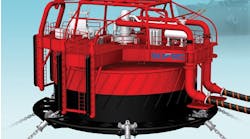Soft switching smoothes data transfer from downhole
Sophisticated electronic and sensitive telemetry equipment downhole can be affected by electrical "noise" or disrupted by power surges which diminish data transmission rates and slow acquisition.
According to Roland Martinez, Senior Engineer at Schlumberger, soft switching is an important technological solution to the noise issue in oil drilling telemetry and data acquisition. "Soft switching is absolutely vital to controlling the high frequency noise that can so easily disrupt the data acquisition process that occurs in oil well logging," he said. "It's vital to avoid power surges when a power supply is turned on. A good 'soft-start' circuit prevents resetting of acquisition control circuits."
Soft switching is a leading-edge technology for programmable DC power supplies that reduces high-frequency noise while also delivering improved efficiency and reliability. Although relatively new, soft switching has already found widespread acceptance among end users. What are the advantages, and where does soft switching find its best applications?
Soft switching is a superior switch-mode power supply topology (technology) that dramatically reduces the electrical noise created by the main power transistors during the switching process, the micro-moment in time when the power supply is switched on and off. The device's main function is to reduce or eliminate radio frequency interference (RFI) and other problems that have been associated with the switching process since the emergence of high-frequency "hard switching" switchmode power supplies in the 1980s.
At that time, there was a rapid increase in the use of electronic products in all manner of industrial applications. This, in combination with the phenomena of RFI and other electromagnetic effects, drew the attention of regulatory bodies around the world. In particular, it became apparent that the large amounts of electromagnetic interference conducted and radiated by this type of supply could interfere with radio communication, and have a negative impact on the operation of sensitive electronic circuits in a variety of industries.
The oil drilling industry is one such case. The main benefit that oil exploration and drillers derive from soft switching is a marked reduction in noise levels. This enables the telemetry coming from below the ground to be detected more easily. "Received from deep-land or deep-sea drilling sites, the data usually has a small amplitude by the time it reaches the recording instruments on the surface," Martinez explained. "It's important the signal-to-noise ratio be adequate to acquire the signals at these great distances. Generating less noise is the key."
With the older, traditional switch-mode power supply technologies, the problem of noise and power surges was a result of power transistors incorporated to "hard-switch" the unregulated input voltage. This means that a transistor turning on will have the whole raw input voltage across it, typically in the range of 350V, as it changes state from on to off. During the actual switching interval (less than 0.5 microseconds), there is a finite period as the transistor begins to conduct during which the voltage begins to fall at the same time as current begins to flow.
This simultaneous presence of voltage across the transistor and current through it means that power is being dissipated within the device during this period. A similar event occurs as the transistor turns off, with the full current flowing through it.
Over the past decade, as the use of computers and other sensitive electronic equipment stacked closely together has increased remarkably in a variety of industries over the last decade. It has become clear that older power supplies must be upgraded or phased out.
Noise reduction
To limit the magnitude of the interference caused by these old hard-switch supplies, during the 1990s the FCC in the US and the European Commission began to impose new regulations on permissible amounts of both radiated and conducted noise, and address electromagnetic and conducted (EMC radiation) emissions, level of immunity to external effects, low voltage and safety and construction issues.
The EMC directive portion of the CE conformity became mandatory on January 1, 1996, and placed legal requirements on companies selling electronic products in the EU. Ensuring the supplies reached the specified performance standards required a considerable engineering re-design effort to lower the EMI (electro-magnetic interference) generated by the units.
In some cases, this change was as simple as adding some new filtering stages to the AC input and DC output, where space allowed. Often, though, the best plan was to introduce new product designs that eliminated the majority of the noise at its source. Soft switching seems to be the answer.
The most common technique employed to do this has been a form of resonant switching in the main power transistors, to ensure the actual energy being switched by the active device is reduced to nearly zero. This greatly decreases the unwanted high-frequency voltage and current transients - the culprits that supply much of the RF noise radiated and conducted out of the power supply.
Soft switching - this change to "zero voltage (or current) switching" - reduces the overall electromagnetic noise in a power supply, and prevents interference with other electronic equipment and radios, as required by the CE standards. How-ever, there are other notable benefits.
Efficiency, lifespan
With soft switching techniques, the power loss that normally occurs as the main power transistors change from a conducting to a non-conducting state, and vice versa, is essentially eliminated. This reduction in wasted power can improve the efficiency of a unit by approximately 2%. While this does not sound significant, it can account for a savings of more than 20 W in a 1000 W power supply. This is all power that would have been dissipated by the main power switches, the most critical components in any switchmode power supply. Reducing the power here lowers their junction temperature, providing increased operating margins and delivering a longer life for the whole power supply.
Not only is significantly less electrical noise generated by a soft switching power supply, the unit is also more efficient, with a longer mean-time-between-failure (MTBF) that is more immune to the effects of other equipment operating nearby. These side effects are important in today's electronic industries, even in extraction industries such as mining and petroleum exploration.
"Oil drilling is becoming highly computerized," notes Martinez. "There's little doubt that soft switching power technologies are now a fundamental component of the electronic data-gathering and power tool control systems used in the global oil drilling industry."
The call by global regulators for a reduction in noise emissions has led to power supplies that operate cleanly, without the rough edges and performance of the previous generation of hard switching supplies.
Author
Mark Edmunds, P. Eng., is Vice President of Advanced Development at Xantrex Technology Inc. of Burnaby, British Columbia.


